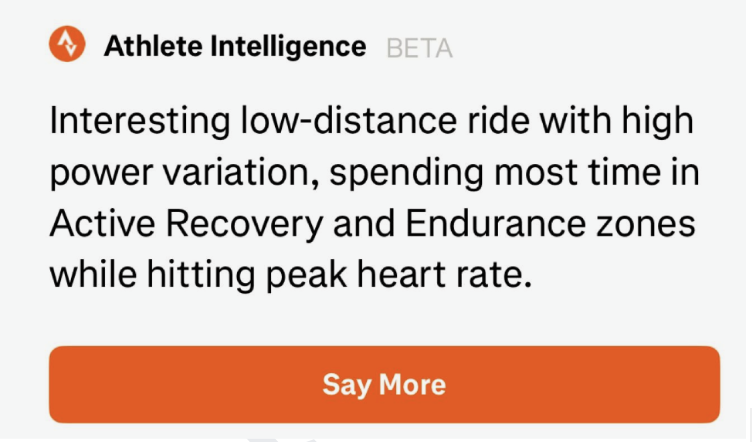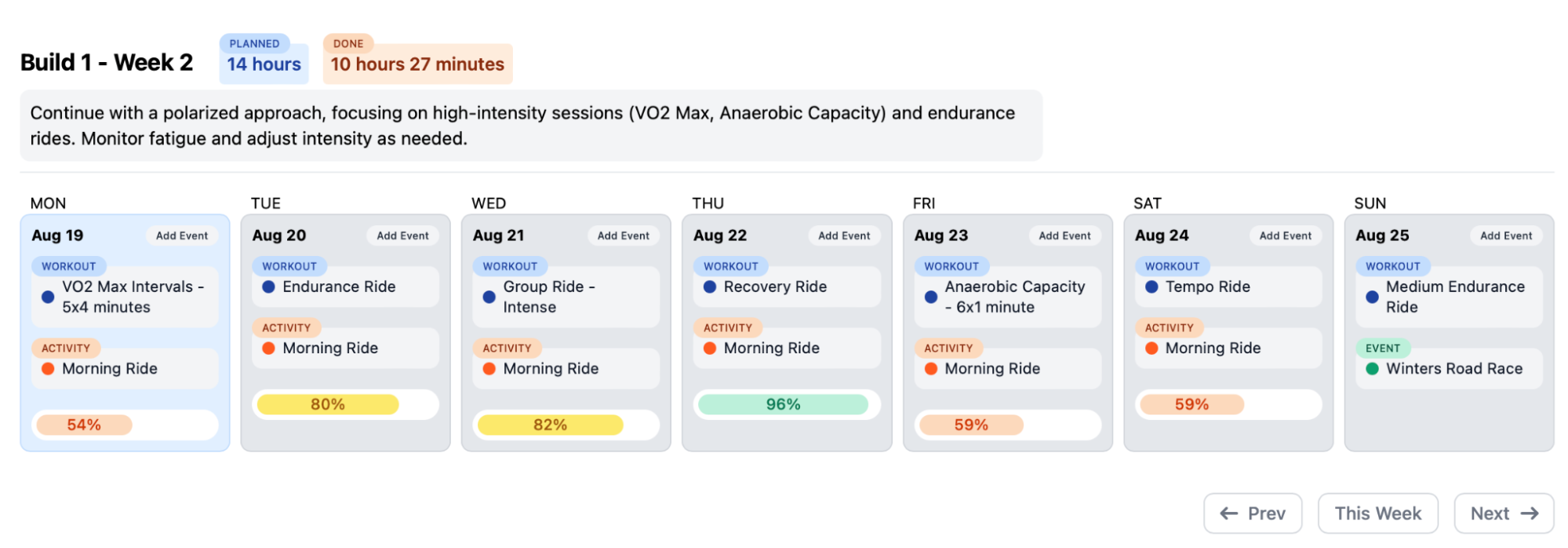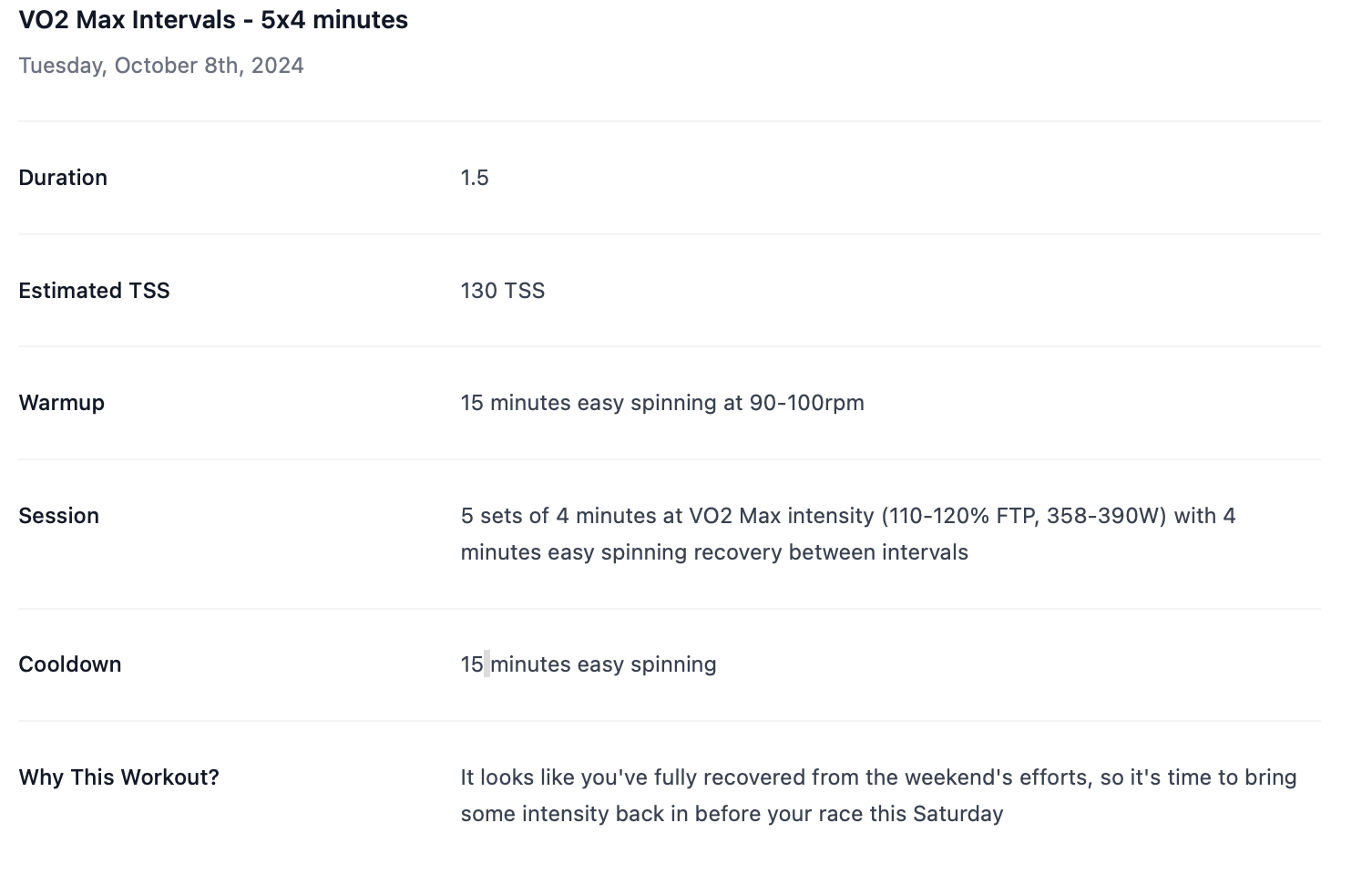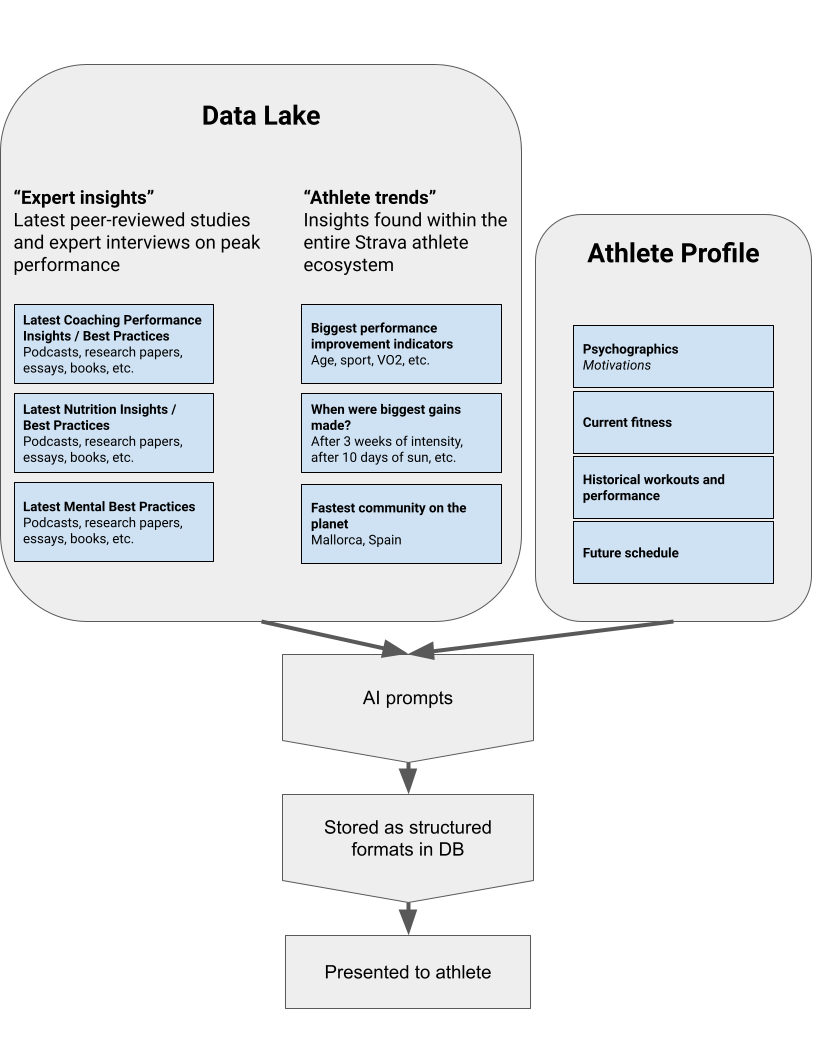Open Letter - Strava, You Can Do AI so Much Better
Dear Strava,
I am a longtime Strava user. It's the first place I go when I'm riding in a new place to connect to the local community, find amazing routes, and long climbs. I've met so many amazing people through Strava.
I strongly believe that Strava has helped me become a better cyclist, and a steward of my local cycling community.
When I'm not riding, I am deeply ingrained in the AI world. I'm an early investor in OpenAI, and have a venture studio (https://halfcorp.co) that invests and builds apps that use AI practically to enrich lives.
Strava has an enormous opportunity to use AI to elevate human potential, but in its current form, it falls short. What could be an intelligent and insightful feature amounts to little more than a snapshot of the activity screen with a generic system prompt.

This is an AI summary for a VO2 workout!
This is just one area that can be vastly improved. Users already expect more from AI, and Strava can deliver. I believe Strava has many untapped opportunities to integrate AI in ways that would go far beyond simple affirmational messages, offering real value to its 100M+ users.
Below is an overview of those recommendations, aligned with Strava's mission to be the leading platform for movement, with the potential to unlock $75M in net new ARR just from the existing user base.
Summary of Recommendations
Personalized, Predictive Coaching
Provides users with tailored guidance to set SMART goals, whether for weight loss, muscle gain, or specific events/races. Training blocks are broken down into yearly, weekly, and daily plans based on the user's fitness level and stated goals, with daily plan adjustments made according to performance metrics. A unique, generated workout menu offers specific exercises to perform each day, with options to change duration, intensity, and focus area, ensuring users can start at their current fitness level and progress over time.
Bespoke Nutrition Plans
Personalized recommendations based on the user's fitness goals and dietary needs, with convenient options for in-app purchases. Users receive customizable macronutrient targets (protein, carbs, fats) to align with their goals, which dynamically adjust based on training load and recovery. Nutrition strategies are generated in tandem with other data for optimizing recovery, including guidance on post-workout meals, hydration, and sleep integration for better rest and muscle repair.
Mental Fitness
An opportunity to acknowledge where physical and mental fitness intersect. Strava can use data that serves as a proxy for "metal toughness" through wearables and collected data, to help users build mental resilience. Personalized recommendations are provided based on real-time data, like heart rate variability, RPE and CTL for managing stress during training and competitions.
Advanced Analytics
AI is uniquely good at pattern recognition. At a macro level, there are incredible insights hiding in plain sight, within Strava's trove of data. Insights that not even world-class coaches know about. Those can be uncovered.
At the individual level, beyond power output, heart rate zones, and progress trends. AI-powered insights provide predictive performance modeling, helping users make adjustments to improve future outcomes. Long-term graphs and reports show how training impacts performance and recovery, with actionable feedback for improvement.
Wearable Integration
Insights on sleep, heart rate variability, and readiness scores can help Strava determine how prepared they are for intense training, and plan/nutrition adjustments.
Ego Boosters
GenAI is used to create personalized affirmations after each workout (not a summary of the workout, but what makes each workout particularly unique), while periodic progress reflections highlight key improvements in fitness, consistency, and goal achievement, helping users stay motivated and proud of their efforts.
Whimsy
A virtual workout buddy that adds humor and motivation to the fitness journey. Users can customize their agent, Memoji-style, which evolves as they make progress. Special themed workouts, where the agent takes on fun personas like a superhero or a zen master, provide an engaging and light-hearted element to the workout experience.
Diving into the details
Personalized Coaching
Goal Setting
Tailored guidance to help users set specific, measurable, achievable, relevant, and time-bound (SMART) goals. Goals can be for weight loss, muscle gain, endurance improvements, or overall health.
Yearly/Weekly/Daily Training Blocks
 (An example of a typical training week on Repth.)
(An example of a typical training week on Repth.)
- Long-term training blocks (based on a "peak date") are broken into weekly and daily plans based on individual fitness levels, goals, and progress.
- Daily adjustments can be made based on performance metrics and user feedback, keeping training adaptive and flexible.
Workout Menu
 (An example of a workout on Repth.)
(An example of a workout on Repth.)
- A generated selection of workouts based on the user's goals and ability levels, with options to filter by duration, intensity, equipment, or focus areas (e.g., core, cardio, strength).
- Each workout could have different levels of difficulty, so users can start from their current fitness level and progress.
- It doesn't just tell the athlete what workout to do, but why, based on all available data.
Bespoke Nutrition Plans
Supplements
- Personalized supplement recommendations based on a user's fitness goals, dietary preferences, and performance data (e.g., protein powder for muscle gain, electrolytes for endurance athletes).
- These could be paired with in-app purchase options or partnered product links for convenience.
Macro Targets
- Customizable macronutrient targets (protein, carbs, fats) tailored to the user's goals, such as weight loss, muscle building, or endurance training.
- Dynamic adjustment based on training load, recovery needs, and weekly progress.
Recovery
- Guidance on nutrition strategies for optimizing recovery, including post-workout meals, hydration techniques, and how to incorporate foods that reduce inflammation and aid muscle repair.
- Optional integration with sleep tracking to provide insights into how nutrition can support better rest and recovery.
Mental Fitness + Recovery
Trend spotting
Identify unique characteristics within the athlete, comparing them against the aggregate athlete community, and find disparities. For example: "You have two intense weeks coming up -- we typically notice that athletes on a similar program feel the most burned out on day 8, so pay special attention on that day to completing your workout.
Mindfulness Practices
Consider the unique psychographic profile of the athlete and what uniquely motivates them (some people do not respond to affirmations, but might respond to something else).
Stress Tracking
Integration with wearable data to monitor stress levels and recommend tailored mental fitness practices based on stress indicators like heart rate variability (HRV).
Advanced Analytics
Progress Trends
Graphs and reports that highlight long-term trends in fitness, performance, and recovery. Users can see how their training affects their results and get suggestions for improvement.
Predictive Performance Modeling
AI-driven insights that predict future performance based on current progress, suggesting adjustments to improve outcomes in races or specific fitness goals.
Comparison to Athlete Community
Compare the athlete's performance trends to the full community of 100M+ athletes, finding unique "diffs," both good and bad.
Ego Boosters
Unique Achievements
Milestone Badges: Unique badges or virtual trophies for hitting fitness milestones that go beyond PRs and KOMs, workout streaks, or overcoming tough challenges.
Examples:
- This was your longest ride!
- You've never done this many VO2 intervals before!
- This is the least amount of 0 pedaling I've seen in a 3 hour period!
Leaderboards: Some (not all) of these could be used in alternative leaderboards (i.e. maximum number of 1 min efforts at 10/10 RPE).
Affirmations/Observations
AI-Generated Observations: Personalized affirmations (or, more plainly, observations) after each workout.
Example:
- You had a tempo ride scheduled, but it looks like you hit some 5 second all-out sprint efforts. This may negatively impact your fitness.
Progress Reflections: Weekly or monthly insights that highlight improvements in fitness, consistency, or other key areas, helping users feel proud of their progress.
Whimsy
Cartoon Agent:
- Virtual Workout Buddy: A playful, animated character that provides motivation, humor, and light-hearted commentary throughout the fitness journey.
- Customizable Avatars: Users can create and dress their cartoon agent, which evolves as they progress in their fitness journey. The agent can offer tips, feedback, and encouragement in a fun, engaging way.
- Themed Workouts: Special themed workouts where the cartoon agent might take on a specific persona (e.g., superhero mode for a high-intensity day, zen mode for recovery).
Bring Zwift's virtual personality into virtual workouts: Right now, virtual rides appear almost indistinguishable from outdoor rides. There's a unique opportunity to add some more character to these types of rides.
Memoji:
Apple's Memoji proved hugely popular; Strava users could employ something similar that reflects the intensity of the workout, with the face reflecting the level of suffering:

The Strava AI Data Model

Prompt chain, not zero-shot
Rather than trying to create the perfect 1,000 word prompt, along with a chunk of data, to generate (for example) an Annual Training Plan, with workouts for each day, chain the prompts together.
Example prompt chain
PROMPT 1:
John is a 42 year old male triathlete with a target "A Race" date of October 20th, 2025. Today's date is January 12th, 2025. John can dedicate up to 16 hours per week to training. John has the following schedule constraints: I can only workout for 2 hours max on Saturdays, and can't workout on Mondays.
Generate the macro cycles ONLY for each week, between now and John's "A Race" date, according to the following JSON template:
{ macro_cycle_template }
[insert macro schedule into db]
PROMPT 2:
Using the following macro cycle calendar [prompt 1 output], generate the 4-week micro cycles according to the athlete's availability constraints and goals:
{ micro_cycle_template }
[insert micro schedule into db]
PROMPT 3:
Using the following macro and micro cycle calendar [prompt 1+2 outputs], generate the next week of workouts that the athlete should perform:
{ workout_week_template }
[insert workout schedule into db]
Emphasize structure (JSON) wherever possible
Asking any generated output to be structured ensures lower entropy and more consistent eval passing.
Don't include data that isn't directly relevant
The "helpful assistant" pre-training GPTs try to adhere to everything you tell them. With that in mind, if you provide data that isn't directly relevant to the prompt, the AI can get distracted and jump to incorrect conclusions.
You can see an example of this in Strava's current AI summary offering. If you have the word "birthday" in the ride title, it thinks it's your birthday, even if the ride title was "Happy birthday, wifey!". Data sent to AI should be spoon-fed, with as much context as possible.
Don't be tempted to train your own model
The costs of generating a truly unique AI model are in the tens of millions. And once training is complete, it's obsolete. Strava can still leverage its huge trove of data while stapling it onto existing frontier AI platforms (which are continuing to train and get better).
Use evals
Test prompts and data using evals to see how often they comply with all of the rules vs. missing.
Example eval for generating a week of workouts:
Each week starts on Monday, ends on Sunday.
The hours of workouts you prescribe should align as closely as possible to the athlete's stated availability.
"warmup" and "cooldown" are optional depending on the workout (for example, endurance and recovery rides do not need warm ups or cool downs), but "session" and "description" should always be included in every workout.
"duration" should always be specified in hours.
For fields that contain numbers, only include numbers in your response, or my script will break.
Interval durations and intensities align with established protocols for VO2max, threshold, sweet spot, endurance training etc.
Total weekly TSS and duration for the week should closely align with the stated TSS and hourly goal. It should also be realistic and safe given my current training load.
estimated_intensity_factor and estimated_variability_index should always be included, because I use those to compare rides.
Adequate recovery is provided between hard workouts. If any of the prescribed workouts seem unrealistic or not achievable, please adjust them before responding.
Recovery weeks should have much lower prescribed durations, even if it's far below the rider's stated availability.
Before responding, make sure the prescribed hours for the week do not exceed the athlete's weekly limit.
Don't generate in a vacuum
Don't use AI to generate generic recommendations and then "curate" them algorithmically to the user. Use AI all the way down the stack, to the individual day for the individual user, asking them for feedback along the way.
Leverage AI for low-entropy tasks
Use AI for finer grained tasks, almost one question in/one answer out. They can be aggregated into something larger, but for individual prompts, the task should be "small."
Combine AI assistance with human creativity
Blend AI-generated ideas with industry expertise, intuition, and creative problem-solving to innovate training or nutrition programs.
In other words, the attitude should be: we know what's best, here it is. Can you adapt this for this particular athlete, with an eye to X, Y, Z?
Don't over-prompt
GPTs are amazing at pattern recognition. Sometimes the better prompt is: "here's a huge chunk of athlete performance data. What do you see?" If the prompt is more like "Look for areas that meet X, but not Y, and sometimes Z, except on Tuesdays," the AI can lose the plot and generate weaker output.
Adapt to evolving AI capabilities
Frontier AI developments are improving noticeably, almost daily. It's a huge whiff to implement basic AI summarization without looking at new features that are available, like evals, structured outputs, the ChatGPT Voice API, etc.
Prioritized Recommendations
Below are these developments stack-ranked, with regard for overall impact, and development difficulty. (Legend - Reach: how many athletes will this be relevant for? Impact: how integral will this feature be to them? Confidence: how confident are you in those numbers? Effort: how much of a development "lift" will this be?)
| Feature | Reach | Impact | Confidence | Low Effort |
|---|---|---|---|---|
| Personalized Goal Setting | 9 | 8 | 9 | 6 |
| SMART Goal Guidance | 8 | 9 | 9 | 6 |
| Yearly/Weekly/Daily Training Blocks | 8 | 9 | 9 | 6 |
| Data-Driven Workout Suggestions | 8 | 8 | 9 | 6 |
| Trend Spotting in Athlete Data | 8 | 8 | 9 | 6 |
| Community Performance Comparisons | 8 | 9 | 8 | 6 |
| Unique Milestone Badges | 9 | 9 | 7 | 6 |
| Alternative Leaderboards | 9 | 8 | 7 | 6 |
| AI-Driven Performance Modeling | 7 | 7 | 9 | 6 |
| Weekly/Monthly Progress Reflections | 8 | 7 | 7 | 7 |
| Bespoke Nutrition Plans | 6 | 8 | 8 | 6 |
| Mental Fitness Tracking | 7 | 8 | 7 | 6 |
| Advanced Progress Analytics | 7 | 7 | 8 | 6 |
| Personalized AI Workout Observations | 7 | 7 | 7 | 6 |
| Performance Trend Graphs | 7 | 6 | 5 | 8 |
| Cartoon Workout Buddy | 8 | 5 | 5 | 3 |
| Customizable Virtual Avatars | 8 | 5 | 5 | 3 |
Revenue Projections
Current revenue (est.)
- 100M users
- 2M paid - $11.99/month
- $24M/month / $288M/year
Estimated demand
| Coaching | Nutrition | Mental | Advanced Analytics | |
|---|---|---|---|---|
| # of Paid Users | 200,000 | 250,000 | 50,000 | 50,000 |
"Plan" Module - $6/month
Net New ARR: $24M
Includes coaching with no modifications, i.e. a one-and-done training plan for the year, no nutrition, or mental components.
"AI Coach" Module - $8/month
Net New ARR: $50M
Includes coaching with daily performance analysis, plan adjustments and scheduling. Also includes all nutrition and mental components
Expense Projections
"AI summaries per activity" is one of the most expensive uses of AI, because every single activity needs to be run through an inference model to generate the summary. And the summary itself isn't very useful!
Savings can be found by using the latest Llama 3.3 70b model, which is approaching GPT-4 parity, and can run on modest hardware, but it still is a lot of compute for what is ultimately not a very helpful feature.
The prioritized features listed above have the potential to be run a single time, even as little as once a quarter, with guardrails on input/output tokens, making the features not only useful, but predictable and low cost.
Prioritized Features Expense Estimation
| Feature | Input Tokens / User | Output Tokens / User | Frequency | Est. Monthly Cost |
|---|---|---|---|---|
| Personalized Goal Setting | 300-500 | 100-200 | Quarterly | $$ |
| SMART Goal Guidance | 200-400 | 50-100 | Quarterly | $$ |
| Yearly/Weekly/Daily Training Blocks | 500-700 | 200-300 | Weekly | $$$ |
| Data-Driven Workout Suggestions | 400-600 | 150-250 | Weekly | $$$ |
| Trend Spotting in Athlete Data | 600-800 | 200-300 | Weekly | $$$ |
| Community Performance Comparisons | 200-400 | 50-100 | NA | $$ |
| Unique Milestone Badges | 100-200 | 50-100 | NA | $ |
| Alternative Leaderboards | 300-500 | 100-200 | Daily | $$$ |
| AI-Driven Performance Modeling | 800-1200 | 300-500 | Weekly | $$$$ |
| Monthly Progress Reflections | 500-700 | 200-300 | Monthly | $$$ |
| Bespoke Nutrition Plans | 800-1000 | 300-500 | Weekly | $$$$ |
| Mental Fitness Tracking | 600-800 | 200-300 | Weekly | $$$ |
| Advanced Progress Analytics | 800-1200 | 300-500 | NA | $$$$ |
| Personalized AI Workout Observations (Summaries) | 500-700 | 200-300 | Daily | $$$$ |
| Performance Trend Graphs | 600-1000 | 200-300 | NA | $$$ |
| Cartoon Workout Buddy | 300-500 | 100-200 | Daily | $$$ |
| Customizable Virtual Avatards | 1000-1500 | 500-700 | Once | $$ |
All features above combined (except for summaries) have an expected incurred expense of $10M per year, netting a clear profit, given the expected revenue generation.
AI Summary Feature Expense Estimation
Inputs
Input tokens per activity: 1,894.
Activities uploaded to Strava per day: 5.7M.
Input tokens per day: 10.8B.
Outputs
AI summary tokens per activity: 100.
Output tokens per day: 570M.
| Model | Input cost/day | Output cost/day | Total/day |
|---|---|---|---|
| GPT-4o-mini ($0.050/M in, $0.400/M out) | $540,000 | $228,000 | $768,000 |
| Llama 3.3 70B | $0 | $228,000 | $228,000 |
Appendix A: Platform Integrations
To generate the best possible AI-output, the following platform integrations are recommended.
- Garmin: Syncs workout, sleep, and recovery data, including heart rate variability, training readiness, and personalized workout plans via Garmin Connect.
- Apple Health / Apple Watch: Provides real-time workout tracking, heart rate monitoring, sleep analysis, and seamless integration with fitness apps for post-workout insights.
- Fitbit: Tracks daily activity, sleep patterns, recovery metrics, and offers real-time feedback on health and wellness.
- Whoop: Delivers detailed recovery, strain, and sleep insights, focusing on daily readiness and activity tracking.
- Eight Sleep: Enhances sleep quality with temperature regulation and sleep tracking for optimized recovery and performance.
- Oura: Tracks sleep, recovery, and readiness, providing insights into overall well-being and daily activity.
- TrainingPeaks: Designed for structured training plans, goal setting, and detailed performance tracking.
- Wahoo: Provides personalized workout plans and performance tracking, especially for cycling and endurance training.
- MyFitnessPal: Tracks macronutrient intake, calories, and meals, providing detailed food logging and nutrition insights.
- LoseIt: A comprehensive platform for tracking dietary intake, calories, and supplements, focused on weight management.
- Cronometer: Offers detailed tracking of both macronutrients and micronutrients, including supplements for optimal nutrition.
- InsideTracker: Provides personalized nutrition and supplement recommendations based on blood biomarkers and health data.
- Zwift: A virtual platform for cycling and running that offers structured workouts, training plans, and a community-based experience.
UPDATE May 5th, 2025: Fixed math
Written on Feb 19th, 2025